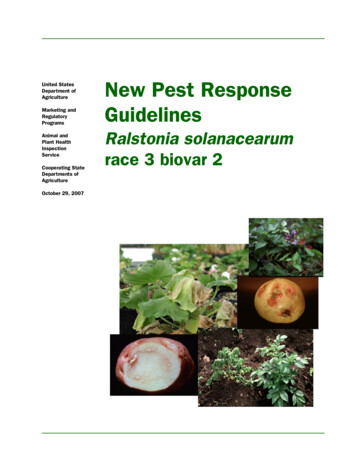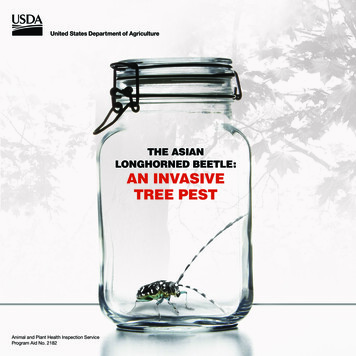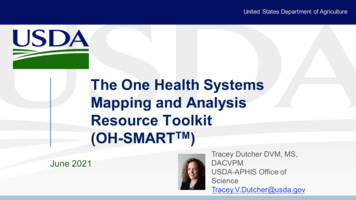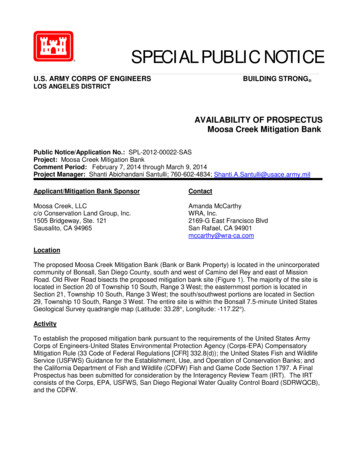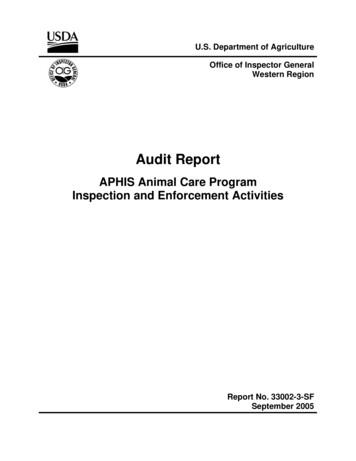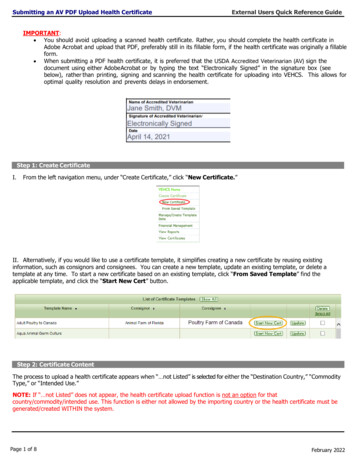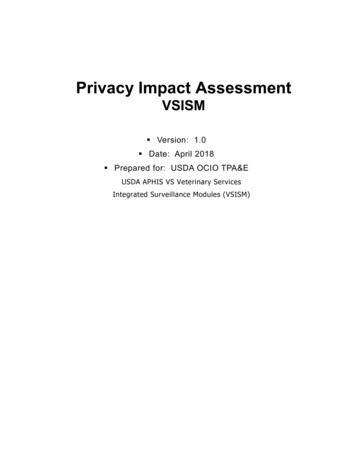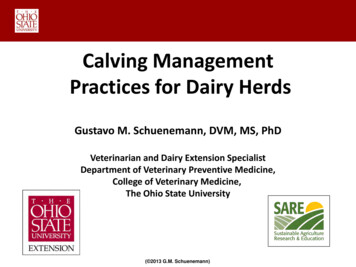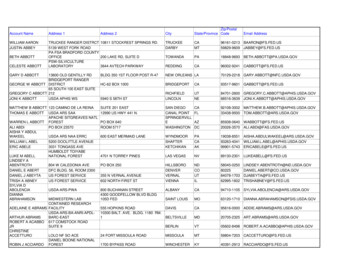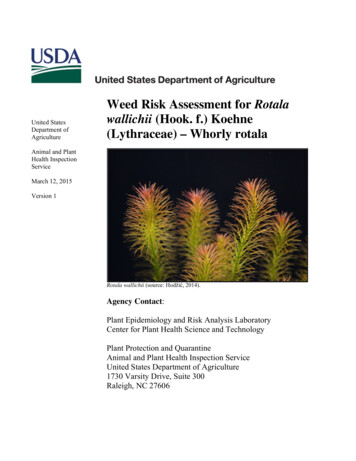
Transcription
United StatesDepartment ofAgricultureWeed Risk Assessment for Rotalawallichii (Hook. f.) Koehne(Lythraceae) – Whorly rotalaAnimal and PlantHealth InspectionServiceMarch 12, 2015Version 1Rotala wallichii (source: Hodžić, 2014).Agency Contact:Plant Epidemiology and Risk Analysis LaboratoryCenter for Plant Health Science and TechnologyPlant Protection and QuarantineAnimal and Plant Health Inspection ServiceUnited States Department of Agriculture1730 Varsity Drive, Suite 300Raleigh, NC 27606
Weed Risk Assessment for Rotala wallichiiIntroduction Plant Protection and Quarantine (PPQ) regulates noxious weeds under the authority ofthe Plant Protection Act (7 U.S.C. § 7701-7786, 2000) and the Federal Seed Act (7U.S.C. § 1581-1610, 1939). A noxious weed is defined as “any plant or plant productthat can directly or indirectly injure or cause damage to crops (including nursery stockor plant products), livestock, poultry, or other interests of agriculture, irrigation,navigation, the natural resources of the United States, the public health, or theenvironment” (7 U.S.C. § 7701-7786, 2000). We use weed risk assessment (WRA)—specifically, the PPQ WRA model (Koop et al., 2012)—to evaluate the risk potentialof plants, including those newly detected in the United States, those proposed forimport, and those emerging as weeds elsewhere in the world.Because the PPQ WRA model is geographically and climatically neutral, it can beused to evaluate the baseline invasive/weed potential of any plant species for the entireUnited States or for any area within it. As part of this analysis, we use a stochasticsimulation to evaluate how much the uncertainty associated with the analysis affectsthe model outcomes. We also use GIS overlays to evaluate those areas of the UnitedStates that may be suitable for the establishment of the plant. For more information onthe PPQ WRA process, please refer to the document, Background information on thePPQ Weed Risk Assessment, which is available upon request.Rotala wallichii (Hook. f.) Koehne – Whorly rotalaSpecies Family: LythraceaeInformation Synonyms: Hydrolythrum wallichii Hooker fil., Ammannia wallichii (Hooker fil.)Kurz., Ammannia myriophylloides S.T. Dunn (Kasselmann, 2003).Common names: Whorly rotala (Dave's Garden, 2015), red pinetree (Clayton et al.,2005; FishandTips.com, 2015).Botanical description: Rotala wallichii is an aquatic, annual herb that grows 5-30 cmhigh (Kasselmann, 2003; Zhengyi et al., 2015). It grows both emerged and fullysubmerged. The leaves are whorled and highly variable depending on the growingconditions; submerged leaves are filiform, while emerged leaves are broader andovate. The shoot tips turn red when exposed to high intensity light in aquariums(Huang et al., 1989; Kasselmann, 2003; Paffrath, 1982; Zhengyi et al., 2015).Initiation: PPQ received a market access request for Rotala macrandra, R.rotundifolia, and R. wallichii aquatic plants for propagation from the Ministry ofFood, Agriculture and Fisheries of the Danish Plant Directorate (MFAF, 2009).These Rotala species are not native to the United States (Kasselmann, 2003) andmay pose a threat to the United States. Thus, the PERAL Weed Team initiated aweed risk assessment for R. wallichii.Foreign distribution: Rotala wallichii is native to Asia, including India, Indonesia,Malaysia, Myanmar, Thailand, Vietnam, Taiwan, and southeastern China(Kasselmann, 2003; Zhengyi et al., 2015). It is cultivated as an ornamental plant inNew Zealand (Champion and Clayton, 2000), Canada (Cohen et al., 2007), andEurope (Marek and Bartova, 1998) and has not become naturalized in any of theareas where it has been introduced.U.S. distribution and status: Rotala wallichii was cultivated as an aquarium plant inthe United States as early as 1977 (Rataj and Horeman, 1977) and is not known tohave escaped or naturalized. This species is not widely available in retail stores, butcan be purchased online (AquaticMag, 2015; NaturalAquariums.com, 2009;Ver. 1March 12, 20151
Weed Risk Assessment for Rotala wallichiiPlanted Aquariums Central, 2015).WRA area1: Entire United States, including territories.1. Rotala wallichii analysisEstablishment/Spread Rotala wallichii is an aquatic plant that grows both emerged and submerged (Paffrath,Potential 1982; Yang, 1987). It is widely cultivated as an aquarium plant (Champion andClayton, 2000; Cohen et al., 2007; Kasselmann, 2003; Rataj and Horeman, 1977), buthas not escaped from cultivation in any area where it has been introduced. Severalother species of Rotala are considered to be invasive (Holm et al., 1979), but R.wallichii does not appear to share many invasive traits with these species. Forexample, the invasive species R. rotundifolia forms dense thickets and disperses byseed (Gettys and Della Torre II, 2014; UF/IFAS, 2015), but R. wallichii does not formdense mats and we found very little information about it producing any seed at all. Wehad very high uncertainty for this risk element.Risk score 0Uncertainty index 0.35Impact Potential We found no evidence that R. wallichii has any negative impacts in naturalenvironments, urban and suburban settings, or production systems. It does notcompete with other plant species or change habitats, and it is not toxic to fish(Kasselmann, 2003). We had an average amount of uncertainty for this risk element.Risk score 1Uncertainty index 0.14Geographic Potential Based on three climatic variables, we estimate that about seven percent of the UnitedStates is suitable for the establishment of R. wallichii (Fig. 1). This predicteddistribution is based on the species’ known distribution elsewhere in the world andincludes point-referenced localities and areas of occurrence. The map for R. wallichiirepresents the joint distribution of Plant Hardiness Zones 9-13, areas with 30-100 inches of annual precipitation, and the following Köppen-Geiger climate classes:tropical rainforest, tropical savanna, and humid subtropical.The area estimated is likely conservative since it only uses three climatic variables.Other environmental variables may further limit the areas in which this species islikely to establish. In its native habitat, R. wallichii grows in shallow water, ponds, wetplaces, paddy fields, and ditches (Huang et al., 1989; Van Steenis, 1961).Entry Potential We did not assess the entry potential of R. wallichii because it is already present in theUnited States in cultivation (Kasselmann, 2003; Rataj and Horeman, 1977).1“WRA area” is the area in relation to which the weed risk assessment is conducted [definition modified from that for “PRAarea”] (IPPC, 2012).Ver. 1March 12, 20152
Weed Risk Assessment for Rotala wallichiiFigure 1. Predicted distribution of R. wallichii in the United States. Map insets forAlaska, Hawaii, and Puerto Rico are not to scale.2. ResultsModel Probabilities:P(Major Invader) 2.8%P(Minor Invader) 46.3%P(Non-Invader) 50.9%Risk Result Low RiskSecondary Screening Not ApplicableVer. 1March 12, 20153
Weed Risk Assessment for Rotala wallichii.Figure 2. Rotala wallichii risk score (black box) relative to the risk scores of speciesused to develop and validate the PPQ WRA model (other symbols). See Appendix Afor the complete assessment.Figure 3. Model simulation results (N 5,000) for uncertainty around the risk score forR. wallichii. The blue “ ” symbol represents the medians of the simulatedoutcomes. The smallest box contains 50 percent of the outcomes, the second 95percent, and the largest 99 percent.Ver. 1March 12, 20154
Weed Risk Assessment for Rotala wallichii3. DiscussionThe result of the weed risk assessment for R. wallichii is Low Risk. Rotalawallichii has a risk score similar to other low risk species (Fig. 2). Because wefound very little information about seed production and dispersal we had very highuncertainty for the establishment/spread risk element, which is demonstrated by thelarge distribution along that axis in Figure 3. However, our results agree withratings by other assessors: the National Centre of Aquatic Biodiversity andBiosecurity in New Zealand lists R. wallichii as a low-risk, environmentallyfriendly aquarium/pond plant (Clayton et al., 2005) and Thomas (2010) rated R.wallichii as a low risk plant for the United Kingdom.Rotala wallichii has been cultivated as an aquarium plant in the United States sinceat least 1977 (Rataj and Horeman, 1977) but has not become naturalized in theUnited States, nor has it escaped from cultivation anywhere else. It does not appearto aggressively compete with other plants; in aquariums, R. wallichii is consideredto be a delicate and demanding plant that is very difficult to grow (FlowGrow,2013; Kasselmann, 2003; Windeløv, 2004), and plant-consuming fishpreferentially feed on this plant (Aquatic Plant Central, 2015; Grieshaber, 2013;Kasselmann, 2003). Additionally, R. wallichii looks very different from otherRotala species (Kasselmann, 2003; Windeløv, 2004) and can be distinguished fromits weedy congeners.4. Literature Cited7 U.S.C. § 1581-1610. 1939. The Federal Seed Act, Title 7 United StatesCode § 1581-1610.7 U.S.C. § 7701-7786. 2000. Plant Protection Act, Title 7 United StatesCode § 7701-7786.APHIS. 2015. Phytosanitary Certificate Issurance & Tracking System(PCIT). United States Department of Agriculture (USDA), Animaland Plant Health Inspection Service ex.jsp. (Archived atPERAL).Aquatic Plant Central. 2015. Rotala wallichii. Plant Finder. Aquatic PlantCentral. Last accessed January 9, lantfinder/details.php?id 76.AquaticMag. 2015. Rotala wallichii. AquaticMag, Nevada, United States.Last accessed January 9, hii/.Bailey, L. H., and E. Z. Bailey. 1976. Hortus Third: A Concise Dictionary ofPlants Cultivated in the United States and Canada. Macmillan,London, United Kingdom. 1290 pp.Brochet, A.-L., M. Guillemain, H. Fritz, M. Gauthier-Clerc, and A. J. Green.2009. The role of migratory ducks in the long-distance dispersal ofnative plants and the spread of exotic plants in Europe. Ecography32(6):919-928.Burrows, G. E., and R. J. Tyrl. 2001. Toxic Plants of North America. WileyVer. 1March 12, 20155
Weed Risk Assessment for Rotala wallichiiBlackwell, Hoboken, New Jersey. 1340 pp.Champion, P. D., and J. S. Clayton. 2000. Border control for potentialaquatic weeds. Stage 1. Weed risk model. Science for Conservation141:1-48.Clayton, J., P. Reeves, P. Champion, and T. Edwards. 2005. Low-riskaquarium and pond plants. Plant Identification Guide. NationalCentre of Aquatic Biodiversity and Biosecurity, National Institute ofWater and Atmospheric Research (NIWA), Wellington, NewZealand.Cohen, J., N. Mirotchnick, and B. Leung. 2007. Thousands introducedannually: The aquarium pathway for nonindigenous plants to the StLawrence Seaway. Frontiers in Ecology and the Environment 5.DOI:10.1890/060137.Dave's Garden. 2015. PlantFiles. Dave's Garden. Last accessed January 9,2015, from http://davesgarden.com/guides/pf/.EDDMapS. 2015. Early Detection & Distribution Mapping System. TheUniversity of Georgia - Center for Invasive Species and EcosystemHealth, Athens, Georgia. Last accessed January 9, 2015,http://www.eddmaps.org/.Figuerola, J., and A. J. Green. 2002. Dispersal of aquatic organisms bywaterbirds: a review of past research and priorities for future studies.Freshwater Biology 47(3):483-494.FishandTips.com. 2015. Rotala wallichii (pine tree). FishandTips.comDatabase. Last accessed January 9, 2015,http://www.fishandtips.com/displaydb.php?ID 61.FlowGrow. 2013. Rotala wallichii. FlowGrow.de. Last accessed January 9,2015, lichii.GBIF. 2015. Data Portal. Global Biodiversity Information Facility (GBIF).Last accessed January 9, 2015, http://data.gbif.org/welcome.htm.Gettys, L. A., and C. J. Della Torre II. 2014. Rotala: A new aquatic invaderin Southern Florida. SS-AGR-376. Institute of Food and AgriculturalSciences (IFAS), University of Florida Extension Service,Gainesville, Florida. 1-4 pp.Graham, S. A., M. Diazgranados, and J. C. Barber. 2011. Relationshipsamong the confounding genera Ammannia, Hionanthera, Nesaea andRotala (Lythraceae). Botanical Journal of the Linnean Society166(1):1-19.Grieshaber, J. 2013. Angels in a Dutch style tank - It's possible! FinTASticJune 2013(29):9-10.Heap, I. 2015. The International Survey of Herbicide Resistant Weeds Lastaccessed January 9, 2015, http://www.weedscience.org.Heide-Jørgensen, H. S. 2008. Parasitic Flowering Plants. Brill Publishers,Leiden, The Netherlands. 442 pp.Hodžić, A. 2014. Rotala wallichii, @N05/. Photograph usedwith permission from Alen Hodžić.Ver. 1March 12, 20156
Weed Risk Assessment for Rotala wallichiiHolm, L. G., J. V. Pancho, J. P. Herberger, and D. L. Plucknett. 1979. AGeographical Atlas of World Weeds. Krieger Publishing Company,Malabar, Florida, U.S.A. 391 pp.Huang, T.-C., S.-F. Huang, and K.-C. Yang. 1989. Notes on the flora ofTaiwan (3) - The miscellaneous plants. Taiwania 34(1):45-53.IPPC. 2012. International Standards for Phytosanitary Measures No. 5:Glossary of Phytosanitary Terms. Food and Agriculture Organizationof the United Nations, Secretariat of the International PlantProtection Convention (IPPC), Rome, Italy.Joseph, K. T., and V. V. Sivarajan. 1988. Rotala cookii: A new species ofLythraceae from India showing Hippuris syndrome. PlantSystematics and Evolution 159(1-2):141-144.Joseph, K. T., and V. V. Sivarajan. 1989. Rotala Linn. (Lythraceae) inpeninsular India. Proceedings: Plant Sciences 99(3):179-197.Kartesz, J. T. 2015. North American Plant Atlas [maps generated fromKartesz, J.T. 2010. Floristic Synthesis of North America, Version1.0. Biota of North America Program (BONAP).]. The Biota ofNorth America Program, Chapel Hill, N.C.http://www.bonap.org/MapSwitchboard.html. (Archived at PERAL).Kasselmann, C. 2003. Aquarium plants. Krieger Publishing Company,Malabar, Florida. 518 pp.Keller, R. P., and D. M. Lodge. 2007. Invasions from commerce in liveaquatic organisms: Problems and possible solutions. BioScience57(5):428-436.Knuth, P., and H. Müller. 1906. Handbook of flower pollination: Basedupon Hermann Müller's work 'The fertilisation of flowers by insectsʼ,Volume 1. Clarendon Press, Oxford, United Kingdom. 382 pp.Koop, A., L. Fowler, L. Newton, and B. Caton. 2012. Development andvalidation of a weed screening tool for the United States. BiologicalInvasions 14(2):273-294.Mabberley, D. J. 2008. Mabberley's Plant-Book: A Portable Dictionary ofPlants, their Classification and Uses (3rd edition). CambridgeUniversity Press, New York, New York. 1021 pp.Maki, K., and S. Galatowitsch. 2004. Movement of invasive aquatic plantsinto Minnesota (USA) through horticultural trade. BiologicalConservation 118(3):389-396.Marek, J., and E. Bartova. 1998. Duponchelia fovealis Zeller, 1847, a newpest of glasshouse plants in the Czech Republic. Plant ProtectionScience 34(4):151-152.Martin, P. G., and J. M. Dowd. 1990. A protein sequence study of thedicotyledons and its relevance to the evolution of the legumes andnitrogen fixation. Australian Systematic Botany 3:91-100.MFAF. 2009. Aquarium plants in growing medium – Denmark - PreRequisite Requirements for Commodity Risk Assessments. Ministryof Food, Agriculture and Fisheries (MFAF), The Danish PlantDirectorate, Denmark, Lyngby, Denmark. 4 pp.Ver. 1March 12, 20157
Weed Risk Assessment for Rotala wallichiiMoody, K. 1989. Weeds: reported in rice in South and Southeast Asia.International Rice Research Institute (IRRI), Manila, Philippines.442 pp.NaturalAquariums.com. 2009. Rotala. NaturalAquariums.com. Lastaccessed January 9, html.Newman, M., P. Thomas, S. Lanorsavanh, S. Ketphanh, B. Svengsuksa, andV. Lamxay. 2007. New records of Angiosperms and Pteridophytes inthe Flora of Laos. Edinburgh Journal of Botany 64(2):225-251.NGRP. 2015. Germplasm Resources Information Network (GRIN). UnitedStates Department of Agriculture, Agricultural Research Service,National Genetic Resources Program (NGRP). language en.Nickrent, D. 2009. Parasitic plant classification. Southern Illinois UniversityCarbondale, Carbondale, IL, U.S.A. Last accessed June 12, tes.html.NRCS. 2015. The PLANTS Database. United States Department ofAgriculture, Natural Resources Conservation Service (NRCS), TheNational Plant Data Center. Last accessed January 9, 2015,http://plants.usda.gov.Paffrath, K. 1982. Das Pflanzenportrait: Rotala wallichii (Hooker) Koehne,1880. Aqua Planta 7(3):13-14.Planted Aquariums Central. 2015. Rotala wallichii, lush, colorful plant.Planted Aquariums Central, Arizona, United States. Last accessedJanaury 9, A-WALLICHIIlush-colorful-plant p 15.html.Randall, J. M. 2007. The introduced flora of Australia and its weed status.CRC for Australian Weed Management, Department of Agricultureand Food, Western Australia, Australia. 528 pp.Randall, R. P. 2012. A Global Compendium of Weeds. 2nd edition.Department of Agriculture and Food, Western Australia, SouthPerth, Australia. 1119 pp.Randall, R. P. 2015. A Global Compendium of Weeds. HawaiianEcosystems at Risk and Department of Agriculture of WesternAustralia. http://www.hear.org/gcw/.Rataj, K., and T. J. Horeman. 1977. Aquarium plants: Their identification,cultivation and ecology. T.F.H. Publications, Neptune, New Jersey448 pp.Riemer, D. N. 1993. Introduction to Freshwater Vegetation. Krieger,Malabar, Florida. 205 pp.Thomas, S. 2010. Here today, here tomorrow? Horizon scanning forinvasive non-native plants. PlantLife, Salisbury, Wiltshire, UnitedKingdom. 20 pp.UF/IFAS. 2015. Roundleaf toothcup, Dwarf rotala. Rotala rotundifolia.Center for Aquatic and Invasive Plants, University of Florida (UF),Ver. 1March 12, 20158
Weed Risk Assessment for Rotala wallichiiInstitute of Food and Agricultural Sciences (IFAS). Last accessedJanuary 16, 2015, http://plants.ifas.ufl.edu/node/664.Van Steenis, C. G. 1961. Miscellaneous botanical notes XI. Blumea11(1):132-139.Watanabe, H. 2011. Development of lowland weed management and weedsuccession in Japan. Weed Biology and Management 11(4):175-189.Windeløv, H. 2004. Tropica Aquarium Plants Catalogue. Tropica AquariumPlants, Egå, Denmark. 97 pp.Yang, Y.-P. 1987. A synopsis to the aquatic angiospermous plants ofTaiwan. Botanical Bulletin of Academia Sinica 28:191-209.Zhengyi, W., P. H. Raven, and H. Deyuan. 2015. Flora of China. MissouriBotanical Garden Press, St. Louis, Missouri. Last accessed January3, 2015, http://flora.huh.harvard.edu/china/.Ver. 1March 12, 20159
Weed Risk Assessment for Rotala wallichiiAppendix A. Weed risk assessment for Rotala wallichii (Hook. f.) Koehne (Lythraceae). The followinginformation came from the original risk assessment, which is available upon request (full responses andall guidance). We modified the information to fit on the page.Question IDAnswer –ScoreUncertaintyESTABLISHMENT/SPREAD POTENTIALES-1 (Status/invasiveness b - low-2outside its native range)ES-2 (Is the specieshighly domesticated)n - low0ES-3 (Weedy congeners)y - low1ES-4 (Shade tolerant atsome stage of its lifecycle)y - negl1Ver. 1Notes (and references)Rotala wallichii is native to Asia, including India, Indonesia,Malaysia, Myanmar, Thailand, Vietnam, Taiwan, andsoutheastern China (Kasselmann, 2003; Zhengyi et al., 2015.Listed as "very rare" in Taiwan (Yang, 1987). Occurs in Laos(Newman et al., 2007). Cultivated as an aquarium plant in theUnited States some time before 1977 (Rataj and Horeman,1977). Cultivated as an ornamental and not naturalized in NewZealand (Champion and Clayton, 2000). Cultivated as anornamental plant in Canada (Cohen et al., 2007). Cultivated inglasshouses in the Czech Republic (Marek and Bartova, 1998).Rotala wallichii is not listed in PLANTS (NRCS, 2015), GRIN(NGRP, 2015), BONAP (Kartesz, 2015), or EDDMapS(2015). We answered "b" because R. wallichii is cultivated asan aquarium plant and we found no evidence of it escapingcultivation where it has been introduced. The alternate answersfor the Monte Carlo simulation were “a” and “d.”We found no evidence of breeding efforts to select desirablecultivars. Rotala wallichii is commonly just sold under itsspecies name rather than by any cultivar names (AquaticMag,2015; Planted Aquariums Central, 2015).There are over 40 species in the genus Rotala (Graham et al.,2011; Joseph and Sivarajan, 1988). Of these, Holm et al.(1979) list R. indica as a serious weed in Afghanistan, Japan,Korea, the Philippines, and Taiwan; R. mexicana as a principalweed in Japan; R. rotundifolia as a principal weed in Taiwan;and R. uliginosa as a principal weed in Korea. Rotalarotundifolia has naturalized and become problematic in canalsin southern Florida (Gettys and Della Torre II, 2014; Grahamet al., 2011). Rotala wallichii may or may not share traits withother Rotala species; R. wallichii is an allopatric species(evolving through genetic isolation from other Rotala species)that mimics plants in the genus Hippuris. It was previouslyplaced in the monotypic genus Hydrolithrum (Joseph andSivarajan, 1988). Thus, we used low uncertainty rather thannegligible.In Asia, this species "is much more often found growingsubmerged and in deeper water than related species" (AquaticPlant Central, 2015). Grows " on rocks and logs in full sunor shade" (Clayton et al., 2005). Requires medium to very highlight in aquariums (Windeløv, 2004; Clayton et al., 2005), andhigh light intensity in order to produce red shoot tips(Kasselmann, 2003). Because a very low amount of light isavailable to fully submerged plants (Riemer, 1993), weanswered yes with negligible uncertainty. We believe that thisspecies is very plastic and is able to grow in a wide range oflight regimes, from shady to very bright.March 12, 201510
Weed Risk Assessment for Rotala wallichiiQuestion IDAnswer –Uncertaintyn - neglScoreNotes (and references)0ES-6 (Forms densethickets)n - high0ES-7 (Aquatic)y - negl1ES-8 (Grass)n - negl0ES-9 (Nitrogen-fixingwoody plant)n - negl0ES-10 (Does it produceviable seeds or spores)? - max0ES-11 (Self-compatible orapomictic)? - max0ES-12 (Requires specialpollinators)? - maxES-13 (Minimumgeneration time)b - low1ES-14 (Prolificreproduction)n - high-1ES-15 (Propagules likelyto be dispersedunintentionally by people)? - max0ES-16 (Propagules likelyto disperse in trade ascontaminants orhitchhikers)? - max0Rotala wallichii is neither a vine nor an herb with a basalrosette; it is an aquatic plant that grows 5-15 cm high (Josephand Sivarajan, 1988).Large populations of R. wallichii have been observed (VanSteenis, 1961), but we found no evidence that thesepopulations are particularly dense or crowd out other species.Thus, we answered no, but used high uncertainty.Rotala wallichii is an aquatic plant (Joseph and Sivarajan,1988) that grows both submerged (Clayton et al., 2005) andemerged (Paffrath, 1982; Yang, 1987).Rotala wallichii is not a grass; it is in the family Lythraceae(Huang et al., 1989; Paffrath, 1982).Rotala wallichii is a herbaceous plant (Huang et al., 1989) andthe family Lythraceae is not known to contain nitrogen-fixingspecies (Martin and Dowd, 1990).Zhengyi et al. (2015) describe the seeds of R. wallichii, butKasselmann (2003) says "fruit not seen." We did not find anyinformation about seed reproduction or propagation Thus, weanswered unknown.The genus Rotala contains species with cleistogamous flowers(which are non-opening, self-pollinating flowers) (Knuth andMüller, 1906) but we only found vague information aboutpollination in R. wallichii from an aquarium website:"Reproduction is done by flowers in the wild (male and femaleplants)" (FishandTips.com, 2015). Thus, we answeredunknown.Unknown. The flowers of R. wallichii possess nectar scales(Joseph and Sivarajan, 1988) but we found no indication thatthese scales attract pollinators.The species is an "annual herb" (Huang et al., 1989). Thefamily Lythraceae mainly contains annual species (Bailey andBailey, 1976). However, this species is called a perennial inother sources (Clayton et al., 2005; Zhengyi et al., 2015). InChina, R. wallichii flowers and fruits in autumn and winter(Zhengyi et al., 2015). Based on this evidence, we answered"b" with low uncertainty. The alternate answers for the MonteCarlo simulation were "c" and "a."Rotala wallichii forms inflorescences but "fruit not seen"(Kasselmann, 2003). "Ammannia, Nesaea and Rotala have.c.200 or more minute brown seeds per capsule" (Graham et al.,2011). Because we found very little information about thisplant producing seeds in general, we answered no, but usedhigh uncertainty.Rotala wallichii has been incorrectly labeled as mayaca in theaquarium trade (Rataj and Horeman, 1977), which couldcontribute to unintentional dispersal. However, because wehad no direct evidence of this, we answered unknown.We found no evidence that R. wallichii has been found as acontaminant, but aquatic plants in general are oftenunintentionally dispersed through the aquarium trade (Kellerand Lodge, 2007; Maki and Galatowitsch, 2004). Thus, weanswered unknown.ES-5 (Climbing orsmothering growth form)Ver. 1March 12, 201511
Weed Risk Assessment for Rotala wallichiiQuestion IDES-17 (Number of naturaldispersal vectors)ES-17a (Winddispersal)ES-17b (Waterdispersal)ES-17c (Bird dispersal)Answer –Uncertainty1ScoreNotes (and references)-2Fruit and seed descriptions used to answer ES-17a-e:"Capsules globose, ca. 1 mm in diam., 2-valved. Seeds ca. 0.7mm" (Zhengyi et al., 2015). "Ammannia, Nesaea and Rotalahave.c. 200 or more minute brown seeds per capsule"(Graham et al., 2011) Members of the genus Rotala haveobovoid to semi-ovoid (boat-shaped) seeds that are brown,gold, or red, and 0.3-1 x 0.2-0.4 mm in size that containaerenchymatous float tissue (Graham et al., 2011).We found no evidence that R. wallichii disperses in thismanner. The seeds have no adaptations for wind dispersal.Rotala species have boat-shaped seeds that are buoyant due totheir aerenchymatous float tissue (Graham et al., 2011).Additionally, the stems of R. wallichii break easily(FishandTips.com, 2015), which likely contributes topropagule dispersal in water. We answered yes with negligibleuncertainty based on these adaptations and because R.wallichii is an aquatic plant.Waterfowl disperse many aquatic plant species (Brochet et al.,2009; Figuerola and Green, 2002). Other members of thegenus Rotala (R. ramosior and R. repens) have exotestal seedtrichomes that appear when seeds are wetted. The seeds thenbecome viscid and can attach to animals that can disperse theseeds (Graham et al., 2011; Mabberley, 2008). However, it isunclear if this occurs in R. wallichii, so we answered unknown.Other Rotala species (e.g., R. ramosior and R. repens) haveseed trichomes that appear when seeds are wetted. The seedsthen become viscid and can attach to animal dispersal agents(Graham et al., 2011; Mabberley, 2008). However, it is unclearif this occurs in R. wallichii. Thus, we answered unknown.We found no evidence that R. wallichii disperses in thismanner. We used high uncertainty because very littleinformation was available on R. wallichii seed production anddispersal in general.We found no evidence that R. wallichii has a persistent seedbank. We used high uncertainty because we found very littleinformation about seeds in general for this species.n - mody - negl? - maxES-17d (Animalexternal dispersal)? - maxES-17e (Animal internaldispersal)n - highES-18 (Evidence that apersistent ( 1yr)propagule bank (seedbank) is formed)ES-19 (Tolerates/benefitsfrom mutilation,cultivation or fire)n - high-1y - high1ES-20 (Is resistant tosome herbicides or has thepotential to becomeresistant)n - high0Ver. 1Propagated by lateral shoot cuttings (Kasselmann, 2003)."[S]uitable for small aquariums because it is easy to prune if itgrows too large" (Windeløv, 2004). Shoot cuttings quickly reroot if planted in substrate (FlowGrow, 2013). The stems of R.wallichii break easily (FishandTips.com, 2015). Mechanicalcontrol of the related species R. rotundifolia can dispersevegetative propagules (Gettys and Della Torre II, 2014). Basedon this evidence, we answered yes, but used high uncertainty.We found no evidence that R. wallichii has been targeted forcontrol by chemical herbicides. However, Rotala indica var.uliginosa has evolved resistance to group B/2 herbicides usedin rice fields in Japan (Heap, 2015). The herbicide 2,4-D iseffective at controlling R. indica (Watanabe, 2011) andtriclopyr and 2,4-D are effective at controlling R. rotundifolia(Gettys and Della Torre II, 2014). Based on this information,we answered no, but used high uncertainty.March 12, 201512
Weed Risk Assessment for Rotala wallichiiQuestion IDES-21 (Number of coldhardiness zones suitablefor its survival)ES-22 (Number ofclimate types suitable forits survival)ES-23 (Number ofprecipitation bandssuitable for its survival)IMPACT POTENTIALGeneral ImpactsImp-G1 (Allelopathic)Imp-G2 (Parasitic)Answer –Uncertainty5Score3081n - modn - negl00We found no evidence that R. wallichii is allelopathic.We found no evidence that R. wallichii is a parasitic plant. Thefamily Lythraceae is not known to contain parasitic plants(Heide-Jørgensen, 2008; Nickrent, 2009).0Impacts to Natural SystemsImp-N1 (Changen - modecosystem processes andparameters that affectother species)Imp-N2 (Changecommunity structure)Imp-N3 (Changecommunity composition)Imp-N4 (Is it likely toaffect federal Threatenedand Endangered species)Imp-N5 (Is it likely toaffect any globallyoutstanding ecoregions)Imp-N6 (Weed status innatural systems)Notes (and references)0n - mod0We found no evidence that R. wallichii has any impacts, or haseven become naturalized, i
We also use GIS overlays to evaluate those areas of the United . (Gettys and Della Torre II, 2014; UF/IFAS, 2015), but R. wallichii does not form dense mats and we found very little information about it producing any seed at all . Phytosanitary Certificate Issurance & Tracking System (PCIT). United States Department of Agriculture (USDA .
